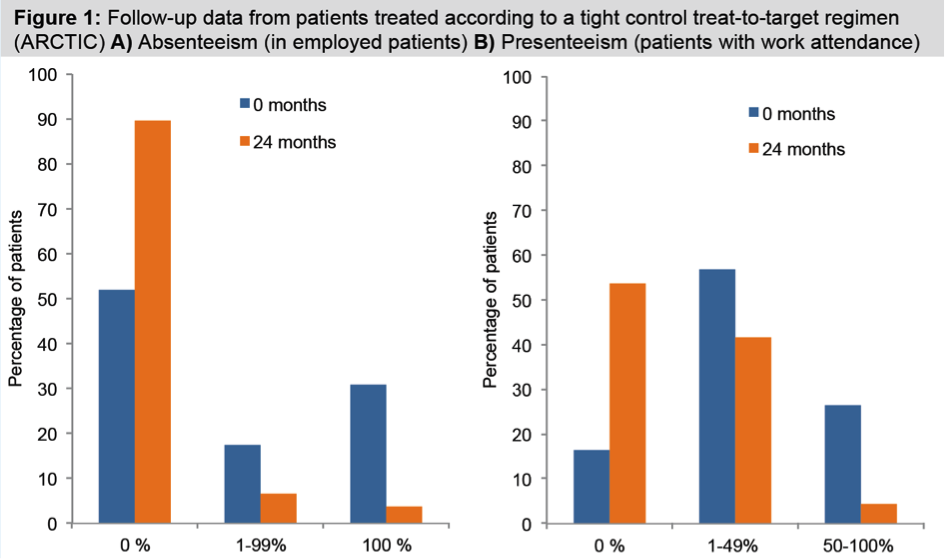Session Information
Session Type: ACR Poster Session C
Session Time: 9:00AM-11:00AM
Background/Purpose: Rheumatoid arthritis (RA) is a known cause of work productivity loss. Participation in work-related activities is defined as part of the primary goal of RA treatment in the 2015 Treat-to-Target recommendations (1). The objective of the current study was to compare sick leave rates in early RA patients in a tight control Treat-to-Target study to early RA patients followed in an observation study without treatment algorithms.
Methods: We used data from two studies, ARCTIC (inclusion Oct 2010 – April 2013, fulfillment of 2010 classification criteria, symptom duration<2 years, DMARD-naive with indication for DMARD) and the NOR-VEAC study (inclusion Oct 2004 – Aug 2010, patients included in the analyses fulfilled 2010 criteria for RA, symptom duration <16 weeks, DMARD-naive). Patients in ARCTIC were treated according to a predefined algorithm with treatment target of DAS<1.6 and SJC44=0. In half the patients, an additional target was no ultrasound power Doppler signal. NOR-VEAC patients were treated according to the physicianÕs preference. Data collection included identical questions on work participation, and in the ARCTIC study additionally the Work Productivity and Activity Impairment Questionnaire. We compared the proportion of patients reporting sick leave among patients not reporting retirement or disability pension across studies at baseline, 8 and 16 months, the time points with most data available in both cohorts, by chi-square test.
Results: The mean (SD) age for the 229 patients in ARCTIC was 51.4 (13.7) years, disease duration 7.1 (5.4) months, DAS28 4.4 (1.2), 61% were female and 86% seropositive. The 259 NOR-VEAC patients had shorter mean (SD) disease duration (2.0 (1.0) months, p-value <0.001), higher DAS28 (5.3 (1.3), p-value<0.001) and lower seropositivity rate (74%, p-value <0.001). NOR-VEAC patients had comparable age (52.7 (14.1) years) and gender distribution (64% females) to ARCTIC. In ARCTIC, levels of presenteeism and absenteeism at two years were overall very low, with substantial improvement from baseline (figure 1). While 30.9% of employed ARCTIC patients reported 100% absenteeism at baseline, the corresponding number at 24 months was 3.7%. When comparing the cohorts after 16 months 14.5% of patients in ARCTIC and 26.1% of patients in NOR-VEAC reported any sick leave (p-value 0.01). No difference in sick leave was found between ARCTIC and NOR-VEAC at baseline but a trend was observed at 8 months (figure 2). 

Conclusion: Patients with early RA in a tight control treat-to-target study reported very little work productivity loss after two years. Sick-leave rates were significantly lower than in a previous cohort of early RA patients followed without implementation of such principles. The results support that patient care based on modern treatment strategies improves participation in work-related activities, a defined goal for RA treatment. References: (1) Smolen et al. ARD 2015
To cite this abstract in AMA style:
Lillegraven S, Mjaavatten MD, Sundlisater NP, Aga AB, Olsen IC, Uhlig T, Solomon DH, Kvien TK, Haavardsholm EA. Work Productivity in Early Rheumatoid Arthritis Patients Treated before and after Implementation of a Treat-to-Target Strategy [abstract]. Arthritis Rheumatol. 2016; 68 (suppl 10). https://acrabstracts.org/abstract/work-productivity-in-early-rheumatoid-arthritis-patients-treated-before-and-after-implementation-of-a-treat-to-target-strategy/. Accessed .« Back to 2016 ACR/ARHP Annual Meeting
ACR Meeting Abstracts - https://acrabstracts.org/abstract/work-productivity-in-early-rheumatoid-arthritis-patients-treated-before-and-after-implementation-of-a-treat-to-target-strategy/
